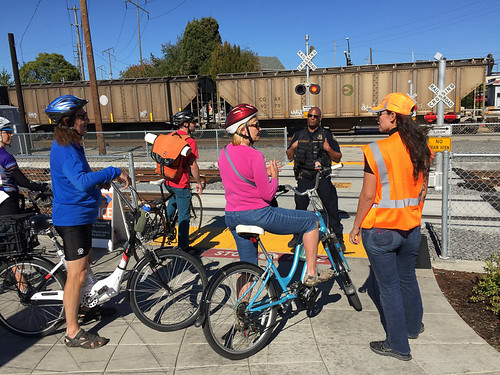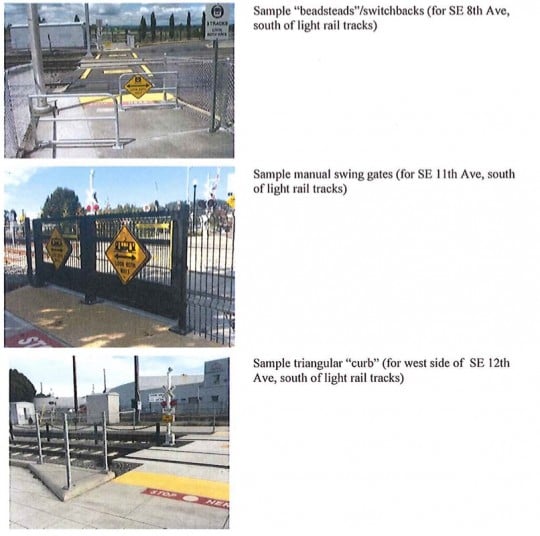
(Photos © J. Maus/BikePortland)
Despite opposition from the city’s official biking and walking advisory committees, TriMet plans to install manual “swing” gates at crossings of the Orange Line in inner southeast Portland.

“double threats,” the type of collision
that caused serious injuries to a
Beaverton man last month.
Back in July, TriMet proposed plans back to install manual gates at two major inner southeast light rail and railroad crossings. The decision stemmed from the agency’s serious safety concerns where new paths cross Orange Line light rail and Union Pacific Railroad tracks. That initial proposal called for two sets of swing gates on the north and south sides of SE 8th and 11th.
That plan was strongly opposed by the Bureau of Transportation’s Bicycle Advisory Committee and the Pedestrian Advisory Committee. In a letter to TriMet, BAC Chair Ian Stude wrote that his committee didn’t support the gates because of, “the operating difficulties they will impose on members of the traveling public – principally those who are bicycling or walking.”
Advertisement
Now TriMet is back with a new plan. Here are the details (from a 9/24 letter from TriMet Community Affairs Manager Jennifer Koozer to BAC Chair Ian Stude):
1. By the end of October, install features to help slow people entering the crossings from the adjacent multiuse path:
- SE 8th Ave: install “bedsteads”/switchbacks on south side of light rail tracks (total of two locations)
- SE 11th Ave: install manual swing gates on the south side of light rail tracks (total of two locations)
- West side of SE 12th Ave: install triangular “curb” on south side of light rail tracks that helps position people crossing at a right angle.
2. After installation, continue to monitor crossing behaviors and evaluate performance of crossing treatments.
3. Continue efforts to adjust heavy rail signal timing, in order to maximize unnecessary signal activation. This requires collaboration and approval by UPRR, a process which will take several months.
TriMet also supplied images showing examples of each type of crossing treatment they plan to install:

As you can see, TriMet has decided to not install a swing gate at 8th but they are keeping one at SE 11th.
We’ve reached out to BAC Chair Ian Stude and several members of the Pedestrian Advisory Committee for comment but have yet to hear back. TriMet will hear directly from them when they bring this new plan to the committee meetings in October. Stay tuned.
UPDATE, 12:30 pm: We heard back from the City of Portland Pedestrian Advisory Committee Co-Chair Rebecca Hamilton. Here’s what she thinks about TriMet’s new plan (emphases mine):
“We appreciate that TriMet considered feedback from the advisory committees and substituted a different treatment for two of the four proposed swing gates. That means we’re halfway to a good solution! But the two remaining swing gates still create an unnecessarily difficult barrier for people using wheelchairs and other mobility devices. No one deserves that disadvantage when there are better ideas on the table.
As life expectancies increase and the Baby Boomer generation ages we’ll be seeing a lot more people using mobility devices to continue leading independent lives. These little decisions matter right now and they’ll matter even more in the future. TriMet has an opportunity to make a smarter choice here to ensure that anyone, regardless of their physical ability, can use their facilities without struggle and the PAC would like to see them make that smarter choice.”
UPDATE, 1:43 pm: And here’s what BAC Chair Ian Stude had to say:
“Our concerns remain the same regarding the swing gates. Those gates, even at that one location, are still problematic. The problem is that they are a barrier that’s constantly present whether there’s a train there or not. Let’s have active gates… Having an active system is more of a vision zero system than a passive gate that’s always there because a passive system looses its efficacy after a while.”

